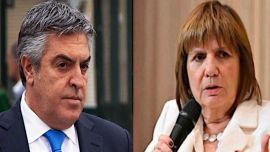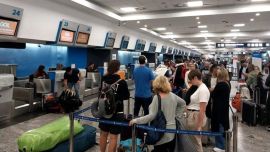The novelty of the quarantine long gone, citizens across Argentina and the globe are beginning to make their way back out into the world. Despite the risks of generating a second wave of Covid-19 infections, and the acceleration of deaths in the metropolitan region of Buenos Aires, coronavirus exhaustion has begun to erode the extraordinary nature of the situation, meaning several interested parties are putting serious pressure on governments to ease lockdowns. This, in Argentina, means society does interpret a dichotomy between the public health emergency and the economic crisis. And, as the foam recedes, the contours of an imploded economy will become visible. In part, this is what the runaway value of the black market exchange rate, or “dólar blue,” are suggesting, reaching records close to 140 pesos that have stretched the black market premium nearly to double the value of the official rate.
The Argentine economy faces a triple threat that could end up being deadlier than the coronavirus outbreak. First and foremost, the embattled nation already suffered an intense recession that was exacerbated by a series of violent devaluations that forced the previous administration to impose capital controls, the infamous cepo that was eliminated to much fanfare by Mauricio Macri in the early days of his 2015-2019 presidency. Thus, before the onslaught of Covid-19, Argentina was already on an unsustainable path as the economic apparatus produces less than the costs of sustaining the country, and, of course, the state. This, then, is one of the major engines behind unrelenting inflation that has become the norm, given the need to constantly print money to finance chronic and structural fiscal deficits. And together, these circumstances put Argentina in a situation in which it is forced to negotiate – once again – its massive debt pile with foreign creditors, meaning it is on the edge of default yet again. It would be the ninth time in the nation’s history, the third this century. Thus, recession-inflation-default threat has created a vicious cycle that is best illustrated by the black market dollar-peso exchange rate.
The effects, of course, are exponential in both directions. The first thing President Alberto Fernández did was declare an emergency. While it is a stalwart move of Peronist governments, it also responded to an extraordinary situation in which the agony of a demand shock would inevitably generate a supply shock in that firms were on the verge of insolvency. Within the private sector it was no secret that the “payments chain” was about to break, begging the question as to how firms would pay salaries, worrying about paying providers at a later stage. Non-existent access to credit made the situation worse. Thus, the velocity with which the novel coronavirus went from “less of a threat than Dengue fever” to an existential enemy with which we are at war actually helped pull a few from the edge, as government bailouts helped cover wages and the state of emergency meant obligations needn’t be honoured at this time.
Yet, as the Central Bank led by Miguel Pesce has gone on a money-printing frenzy (that was initiated by Guido Sandleris) to finance the emergency response to the pandemic, upward pressure has begun to mount on the exchange rate. Under strict currency controls, the peso had remained relatively unharmed compared to its peer group of emerging market currencies, particularly in Latin America where Brazil has suffered a powerful devaluation. The pesos being injected into the system – an emergency tool that few have questioned domestically and abroad – haven’t purely been used to finance direct consumption of basic goods and services such as food, or absorbed into peso-denominated assets. As is the norm in Argentina, they have found their way into US dollars. Throughout Buenos Aires, delivery guys and gals donning the uniforms of companies like Rappi, Glovo, and PedidosYa have become ubiquitous as delivery becomes the norm. Not only for food, though, as our famous “cuevas” or underground currency exchanges have also picked up on the new trend, creating a new black market rate that has come to be known as “dólar delivery” or “dólar Rappi” – The moral of the story is that Argentines will always find a way to buy dollars.
The value of the US dollar in Argentina has always acted as a sort of “fear index,” but it also has direct effects on prices, meaning it adds to inflationary pressures when it goes up. The sovereign debt restructuring talks being led by Economy Minister Martín Guzmán will go down to the wire, fuelling the panic and therefore demand for dollars as Argentines escape the beleaguered peso. Stagflation is a reality in Argentina despite the INDEC national statistics agency showing a drop in inflation for April to 1.5 percent – its lowest reading since November 2017 when Macri’s Cambiemos ("Let’s Change") coalition had defeated Cristina Fernández de Kirchner in midterm elections and apparently announced the end of her political career. Food and beverage inflation actually surged 3.2 percent, and several major economists are already indicating the risks of Pesce’s aggressive monetary expansion could result in triple digit price growth next year. It is true that Minister Guzmán has made it clear that money printing isn’t a viable solution for Argentina, yet there is no alternative.
This is because Argentina is locked out of voluntary debt markets, of course. Less than a month ago, Perú sold US$3 billion worth of bonds to finance its emergency coronavirus response, seeing its lowest financing costs ever below three percent. Its stimulus plan is expected to cost some 12 percent of GDP. In a context in which German bonds offer negative interest rates and the United States is nearing the zero bound, Guzmán’s offer to bondholders is like an oasis, offering an average interest of 2.3 percent. The offer could be a mirage though, as Argentina would actually have to generate sustainable economic growth in order to return that money, which is why bondholders have been locked in a tense negotiation with Guzmán’s team, asking for higher returns and more money sooner. Both the minister and the president have made it clear they want to avoid a default, and reports indicate vice president Fernández de Kirchner agrees, despite the tough stance portrayed by Guzmán in early public appearances. Whatever comes of it, uncertainty will push the black market rate higher.
The government must tread carefully. It has the chance to continue to navigate the public health crisis effectively while looking to resolve the debt crisis, conditions which would give it further breathing room in the form of continued public support. Internal bickering and political opportunism by both opposition and government — a return to la grieta — are also a major concern, particularly given the appearance of a growing influence of the Kirchnerites on government through appointments linked to the La Cámpora youth organisation led by Máximo Kirchner. Even if they get it all right there could be no real possibility of recovery in the short-term, but allowing division and polarisation to emerge as a consequence of coronavirus exhaustion will ultimately lead us in just one direction: down the same path once again.






















Comments